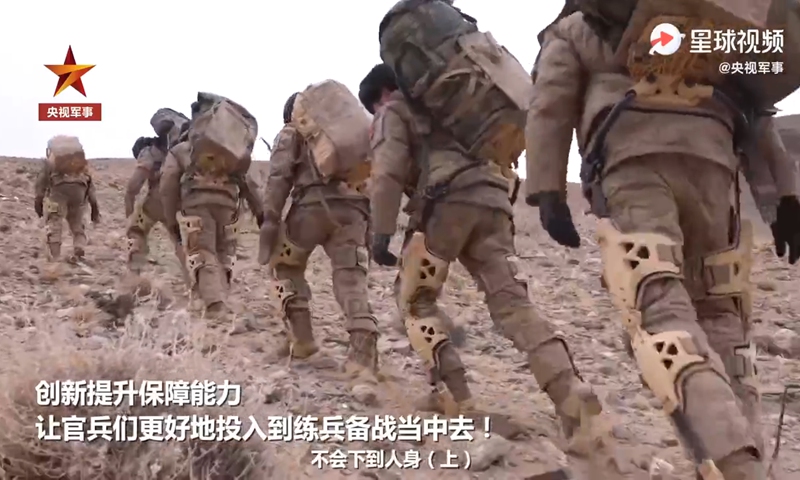Amid the border standoff with India, China has deployed its troops in Ngari in southwest China’s Tibet Autonomous Region. And like superheroes, the Chinese soldiers are wearing ‘exoskeleton’ suits, as depicted in films like Starship Troopers and Iron Man.
Russia Slams The QUAD; Puts India In The Firing Line As Moscow Inches Closer To China
China has joined the US and Russia in the race of producing powered armor or exoskeleton suits. The exoskeleton suits are wearable mobile machines powered with electric motors, pneumatics, levers, hydraulics, or a combination of technologies that allow for limb movement with increased strength and endurance.
But the Chinese troops are using the non-powered suits, yet they provide the required mechanical benefits like reloading artillery, the state-owned media reported.
The exoskeleton suits allow troops to carry supplies that weigh as much as an adult while avoiding the risk of waist or leg injuries, Global Times said. Chinese experts believe these suits will give a physical advantage to troops in the border regions. However, there are no further details on them.

How Do The Chinese Suits work?
China has deployed its troops in the forward posts along the Line of Actual Control, the de facto border with India, in the harsh winters. The Ngari area is in close proximity to the eastern Ladakh region (approximate 200km), where the ongoing border stand-off began.
Quoting a TV news report, Global Times said PLA soldiers attached to the Xinjiang Military Command recently carried food and water during a supply mission. Each person carried about 20 kilograms of these supplies in their backpacks.
A PLA trooper reportedly revealed that the weight of the backpacks is transferred to the frames of the exoskeleton suits, instead of the soldiers’ legs. The suits which appear lightweight in the visuals help the soldeir save energy and protect his joints while moving in high-altitude terrains.
The reports of China testing these suits had first emerged in September and then again in November. In a video clip released by the China Central Television 7 (CCTV 7), the People’s Liberation Army Troops at the country’s Wuxi Joint Logistic Support Centre could be seen using powered exoskeletons to carry 80 kg (175 pound) crates.
Des exosquelettes sont entrées en service dans une unité de destruction des munitions obsolètes de l'armée chinoise. pic.twitter.com/nOxDbiJdsE
— East Pendulum (@HenriKenhmann) October 26, 2020
Another footage from state-media had shown PLA soldiers using what appears to be the same system to carry wounded soldiers on a stretcher as part of a medical evacuation exercise.
PLA troops using some sort of exoskeleton for MEDEVAC purposes.#PLA #China #exoskeleton pic.twitter.com/hVjY5tcKXw
— 𝔗𝔥𝔢 𝔇𝔢𝔞𝔡 𝔇𝔦𝔰𝔱𝔯𝔦𝔠𝔱 🇬🇪🇺🇦🇺🇲🇬🇷 (@TheDeadDistrict) August 24, 2020
Taking a dim of the Chinese ‘Iron Man suits’, Michael Peck wrote in The National Interest that China may discover that these suits work better on film than they do in reality, where hurdles such as ensuring sufficient battery power limit the utility of current exoskeleton designs.
Tough Fight for Exoskeleton Suits
The first exoskeleton research program was started in China in 2013 by state-owned arms maker Norinco for civilian use. According to the US Army’s Foreign Military Studies Office, Norinco’s Northwest Institute of Electrical and Mechanical Engineering completed the digital design, modeling, and physical prototyping of the exoskeleton in two years and it entered environmental testing in 2015.
But of late, the PLA has started testing several exoskeleton suits. It had held a competition “Super Warriors” in 2019, where more than 50 types of exoskeleton prototypes made by 25 developers from all over the country competed in seven areas, including lightweight mobilization, heavy-load marching, supply transport, and munitions loading.
The GT report says that laboratories across the country are producing all kinds of exoskeleton suits, be it powered or non-powered, rigid or flexible, lower-body only or full-body.
A WeChat article quoted by The National Interest says that these suits enhance mobility while carrying heavy loads or adaptability to complex terrain while reducing the physical fatigue in long-duration marching, especially in combat situations.
Russia And The US Are Also In The Race
Samuel Bendett, a research analyst, told Task and Purpose exoskeletons will be used in combat logistics. However, China is not the only country pursuing this technology.
The United States has been experimenting with powered exoskeletons for several decades. In 2013 the US Special Operations Command had announced a tactical assault light operator suit (TALOS) exoskeleton. The suit had armor protection capability and sensors; it could provide the operator with enhanced strength and endurance but it could not achieve the original goal, SOCOM had admitted in 2019.
https://twitter.com/gunfighter2020/status/1311379576573001730
In 2019, US Army Natick Soldier Research, Development and Engineering Centre had initiated a 48-month long Other Transaction Agreement (OTA) worth $6.9m to develop enough exoskeleton systems to conduct a comprehensive operational evaluation.
Of the $6.9m budget, around $680,000 has been put aside for Lockheed Martin’s OTA for its Onyx program — a powered lower-body exoskeleton, according to Army Technology. While the US still doesn’t have an exoskeleton suit, Russia is second after China equipping its troops with these suits.
In October, Russian state-owned defense corporation Rostec had released footage of a new combat exoskeleton for assault operations. There are videos of soldiers with K-2 exoskeletons being engaged in mine clearance operations in Syria.
Author’s Profile: https://eurasiantimes.com/author/ab-aakriti-sharma-zn/
Email: aakrits8@gmail.com
Follow EurAsian Times on Google